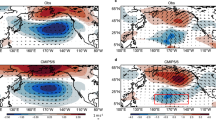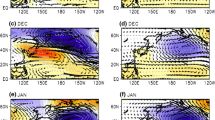Abstract
A number of recent studies have used model projections to investigate how the North Atlantic environment in which tropical storms develop, as well as hurricane activity itself, might change in a warming world. However, accurate projection of the North Atlantic environment in the future requires, at a minimum, accurate representation of its mean state and variability in the current climate. Here we examine one metric of Atlantic basin tropical cyclone variability—its well-documented association with the El Niño-Southern Oscillation (ENSO)—in reanalyses and Intergovernmental Panel of Climate Change (IPCC) 4th Assessment Report (AR4) twentieth century and Atmospheric Model Intercomparison Project simulations. We find that no individual model provides consistently good representation of ENSO-related variability in the North Atlantic for variables relevant to hurricane activity (e.g. vertical wind shear, genesis potential). Model representation of the ENSO influence is biased due to both inaccurate representation of ENSO itself and inaccurate representation of the response to ENSO within the North Atlantic. Among variables examined, ENSO impacts on vertical wind shear and potential intensity were most poorly simulated. The multi-model ensemble mean representation of North Atlantic environmental response to ENSO is better matched with reanalysis than most individual AR4 models; however, this mean response still possesses some considerable bias. A few models do provide comparable or slightly better simulation of these ENSO-North Atlantic teleconnections than the multi-model ensemble average; however, for both the multi-model mean and the well performing models, good simulation of the ENSO-related variability of genesis potential within portions of the North Atlantic does not stem from accurate representation of the ENSO-related variability of the individual environmental variables that comprise genesis potential (e.g. vertical wind shear, potential intensity).









Similar content being viewed by others
References
AchutaRao K, Sperber KR (2006) ENSO simulation in coupled ocean-atmosphere models: are the current models better? Clim Dyn 27:1–15
Bender MA (1997) The effect of relative flow on the asymmetric structure in the interior of hurricanes. J Atmos Sci 54:703–724
Bender MA, Knutson TR, Tuleya RE, Sirutis JJ, Vecchi GA, Garner ST, Held IM (2010) Modeled impact of anthropogenic warming on the frequency of intense Atlantic hurricanes. Science 327:454–458
Bengtsson L, Hodges KI, Esch M, Keenlyside N, Kornblueh L, Luo J-J, Yamagata T (2007) How may tropical cyclones change in a warmer climate? Tellus Ser A 59:539–561
Bister M, Emanuel KA (2002) Low frequency variability of tropical cyclone potential intensity. 1. Interannual to interdecadal variability. J Geophys Res 107:4801–34236. doi:10.1029/2001JD000776
Camargo SJ, Emanuel KA, Sobel AH (2007a) Use of a genesis potential index to diagnose ENSO effects on tropical cyclone genesis. J Clim 20:4819–4834
Camargo SJ, Li H, Sun L (2007b) Feasibility study for downscaling seasonal tropical cyclone activity using the NCEP Regional Spectral Model. Int J Clim 27:311–325
Capotondi A, Wittenberg A, Masina S (2006) Spatial and temporal structure of Tropical Pacific interannual variability in 20th century coupled simulations. Ocean Model 15:274–298
Chang EKM (2007) Assessing the increasing trend in northern hemisphere winter storm track activity using surface ship observations and a statistical storm track model. J Clim 20:5607–5628
DeMaria M (1996) The effect of vertical shear on tropical cyclone intensity change. J Atmos Sci 53:2076–2087
Emanuel KA, Nolan DS (2004) Tropical cyclones and the global climate system’. In: Preprints for 26th conference on hurricanes and tropical meteorology, Miami, Florida. Amer. Meteorol. Soc, Boston
Emanuel K, Sundararajan R, Williams J (2008) Hurricanes and global warming. Bull Amer Met Soc 89:347–367
Emanuel K, Oouchi K, Satoh M, Hirofumi T, Yamada Y (2010) Comparison of explicitly simulated and downscaled tropical cyclone activity in a high-resolution global climate model. J Adv Model Earth Sys 2. doi:10.3894/JAMES.2010.2.9
Frank WM, Ritchie EA (1999) Effects of environmental flow upon tropical cyclone structure. Mon Weather Rev 127:2044–2061
Frank WM, Ritchie EA (2001) Effects of vertical wind shear on the intensity and structure of numerically simulated hurricanes. Mon Weather Rev 129:2249–2269
Garner ST, Held IM, Knutson T, Sirutis J (2009) The roles of wind shear and thermal stratification in past and projected changes of Atlantic tropical cyclone activity. J Clim 22:4723–4734
Gray WM (1968) Global view of the origin of tropical disturbances and storms. Mon Wea Rev 96:669–700
Gray WM (1984) Atlantic seasonal hurricane frequency. Part I: El Niño and 30 mb quasi-biennial oscillation influences. Mon Weather Rev 112:1649–1668
Gulev S, Jung T, Ruprecht E (2007) Estimation of the impact of sampling errors in the VOS observations on air-sea fluxes. Part II: impact on trends and interannual variability. J Clim 20:303–315
Hoerling MP, Kumar A (2002) Atmospheric response patterns associated with tropical forcing. J Clim 15:2184–2203
Joly M, Voldoire A, Douville H, Terray P, Royer JF (2007) African monsoon teleconnections with tropical SSTs: validation and evolution in a set of IPCC4 simulations. Clim Dyn 29:1–20
Jones SC (1995) The evolution of vortices in vertical shear. I: initially barotropic vortices. Q J R Meteorol Soc 121:821–851
Joseph R, Nigam S (2006) ENSO evolution and teleconnections in IPCC’s twentieth-century climate simulations: realistic representation? J Clim 19:4360–4377
Kalnay E et al (1996) NCEP/NCAR 40-year reanalysis project. Bull Amer Met Soc 77:437–471
Kent EC, Woodruff SD, Berry DL (2007) Metadata from WMO publication no. 47 and an assessment of voluntary observing ship observation heights in ICOADS. J Atmos Ocean Tech 24:214–234
Kim H-M, Webster PJ, Curry JA (2009) Impact of shifting patterns of Pacific Ocean warming on North Atlantic tropical cyclones. Science 325:77–80
Knutson TR, Sirutis JJ, Garner ST, Vecchi GA, Held IM (2008) Simulated reduction in Atlantic hurricane frequency under twenty-first-century warming conditions. Nat Geosci 1:359–364
Knutson TR, McBride JL, Chan J, Emanuel K, Holland G, Landsea C, Held I, Kossin JP, Srivastava AK, Sugi M (2010) Tropical cyclones and climate change. Nat Geo 3:157–163
Landsea CW (1993) A climatology of intense (or major) Atlantic hurricanes. Mon Weather Rev 121:1703–1713
Maloney ED, Chelton DB (2006) An assessment of the sea surface temperature influence on surface wind stress in numerical weather prediction and climate models. J Clim 19:2743–2762
Meehl GA et al (2007) The WCRP CMIP3 multimodel dataset—a new era in climate change research. BAMS 88:1383–1394
Neale RB, Richter JH, Jochum M (2008) The impact of convection on ENSO: from a delayed oscillator to a series of events. J Clim 21:5904–5924
Nolan DS, Rappin ED, Emanuel KA (2007) Tropical cyclogenesis sensitivity to environmental parameters in radiative convective equilibrium. Q J R Meteorol Soc 133:2085–2107
Oouchi K, Yoshimura J, Yoshimura H, Mizuta R, Kusunoki S, Noda A (2006) Tropical cyclone climatology in a global-warming climate as simulated in a 20 km-mesh global atmospheric model: frequency and wind intensity analysis. J Met Soc Jpn 84:259–276
Paterson LA, Hanstrum BN, Davidson NE, Weber HC (2004) Influence of environmental vertical wind shear on the intensity of hurricane strength tropical cyclones in the Australian region. Mon Weather Rev 133:3644–3660
Reasor PD, Montgomery MT, Grasso LD (2004) A new look at the problem of tropical cyclones in vertical shear flow: vortex resiliency. J Atmos Sci 61:3–22
Schumacher AB, DeMaria M, Knaff JA (2009) Objective estimation of the 24-h probability of tropical cyclone formation. Weather Forecast 24:456–471
Shaman J, Esbensen SK, Maloney ED (2009) The dynamics of the ENSO-Atlantic hurricane teleconnection: ENSO-related changes to the North African-Asian Jet affect Atlantic Basin Tropical Cyclogenesis. J Clim 22:2458–2482
Shapiro LJ (1987) Month-to-month variability of the Atlantic tropical circulation and its relationship to tropical storm formation. Mon Weather Rev 115:2598–2614
Shapiro LJ (1992) Hurricane vortex motion and evolution in a three-layer model. J Atmos Sci 49:140–153
Thorne PW, Parker DE, Christy JR, Mears CA (2005) Uncertainties in climate trends, lessons from upper-air temperature records. BAMS 86:1437–1442
Trenberth KE, Fasullo J, Smith L (2005) Trends and variability in column-integrated atmospheric water vapor. Clim Dyn 24:741–758
Uppala SM et al (2006) The ERA-40 re-analysis. Q J R Meteorol Soc 131:2961–3012. doi:10.1256/qj.04.176
Vecchi GA, Soden BJ (2007) Increased tropical Atlantic wind shear in model projections of global warming. Geophys Res Let 34:L08702. doi:10.1029/2006GL028905
Vecchi GA, Clement A, Soden BJ (2008) Examining the tropical Pacific’s response to global warming. EOS 89:81–83
Wilson RM (1999) Statistical aspects of major (intense) hurricanes in the Atlantic basin during the past 49 hurricane seasons (1950–1998): implications for the current season. Geophys Res Let 26:2957–2960
Wu C-C, Emanuel KA (1993) Interaction of a baroclinic vortex with background shear: application to hurricane movement. J Atmos Sci 50:62–76
Wu C-C, Emanuel KA (1994) On hurricane outflow structure. J Atmos Sci 51:1995–2003
Yuan X, Patoux J, Li C (2009) Satellite-based midlatitude cyclone statistics over the Southern Ocean: 2. Tracks and surface fluxes. J Geophys Res 114:D04106. doi:10.1029/2008JD010874
Zhao M, Held IM, Lin S-J, Vecchi GA (2009) Simulations of global hurricane climatology, interannual variability and response to global warming using a 50-km resolution GCM. J Clim 22:6653–6678
Acknowledgments
This work was supported by NSF Climate and Large-Scale Dynamics Grant Numbers 0917609 (JS), 0828531, 0946911, and 1025584 (EDM). EDM was also supported under Award #NA080OAR4320893 from NOAA. The statements, findings, conclusions, and recommendations presented here do not necessarily reflect the views of NSF, NOAA, or the Department of Commerce.
Author information
Authors and Affiliations
Corresponding author
Rights and permissions
About this article
Cite this article
Shaman, J., Maloney, E.D. Shortcomings in climate model simulations of the ENSO-Atlantic hurricane teleconnection. Clim Dyn 38, 1973–1988 (2012). https://doi.org/10.1007/s00382-011-1075-4
Received:
Accepted:
Published:
Issue Date:
DOI: https://doi.org/10.1007/s00382-011-1075-4




